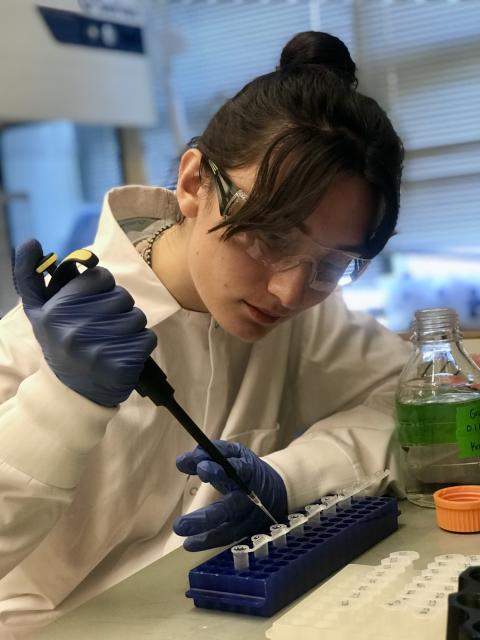Obstacles Are the Building Blocks of Science

Before I began my summer research, I would have told you that by ten weeks in, I would be writing about my promising results and maybe even groundbreaking findings! Instead, I have no results yet… but it isn’t for lack of effort.
As a detail-oriented, curious, and driven individual, I have always been interested in scientific research. Going into my sophomore year, I knew I wanted to get involved in research, and all it took was a few emails to some professors in the Department of Natural Resources and the Environment about the potential of working in their labs to get me started. Before I knew it, I was working as a technician in the Ernakovich Lab (headed by Dr. Jessica Ernakovich) for one of her PhD students, Nate Blais, learning how to do DNA extractions, polymerase chain reactions (PCR), and gel electrophoresis.
I am a rising junior environmental science: ecosystems major from Chester, NH. I was honored to receive a Summer Undergraduate Research Fellowship (SURF) through the Hamel Center for Undergraduate Research this summer to conduct research on how the active microbial community in agricultural soil is affected by microplastic pollution.
My Summer Research with Soil
I began my research in the Ernakovich Lab space in James Hall prior to the summer, as the first part of my project involved an eight-week incubation of agricultural soil from UNH’s Kingman Farm with different concentrations of microplastics to simulate plastic pollution.
During the incubation, I added 18oxygen (18O) isotope labeled water to half the jars in each treatment. Active microbes in soil require water for metabolic activity, and in utilizing water, they incorporate the oxygen in water into their DNA. Thus, by introducing water with the 18O isotope to soil during the incubation, I can trace this labeled water to identify the members of the soil microbial community that are active, which has been my main task during the summer. If certain known plastic-degrading microbes or other microbes are found to proliferate in soil contaminated with microplastics, it could be the first step toward advancing microplastic bioremediation (using soil microbes to break down and remove plastic pollution from the environment).
At the beginning of my summer research, I extracted the DNA from my incubated soil, and have since been working in the Ernakovich Lab space in Rudman Hall using quantitative stable isotope probing (qSIP) to determine which microbes have incorporated the heavier isotope of water. The process of qSIP involves using a stable isotope, in this case 18O, to trace and then quantify the active microbial taxa present in the soil sample. QSIP includes fractionating the heavy (isotope incorporated) and light (isotope not incorporated) DNA via centrifugation, separating the density fractions using a syringe pump, and then preparing the DNA for sequencing by isolating it using polyethylene glycol precipitation.
Part of the end goal of my research is to perfect the qSIP protocol that the Ernakovich Lab currently has so that in the future, graduate and undergraduate students completing research projects can include this process with minimal difficulty. Little did I know that perfecting the qSIP protocol and troubleshooting problems would be my primary tasks over the ten weeks of my SURF.
As I write this blog post in my tenth and final week of research, I still do not have any of the data I had hoped to have compiled by the end of my research. As I have been telling my friends when they ask how my research is going, it seems as though every complication that could have come up has come up, including lab equipment malfunctions, difficulties with the chemistry of reagents, and trying to figure out why the densest layer of liquid was floating at the top of my samples after centrifugation (contradicting the laws of physics). It has been discouraging to say the least. But whenever a new issue comes up, my PhD mentor, Nate, simply declares, “science!” with a big smile on his face and immediately starts helping me create and execute new tests to resolve the problem, or else begins emailing well-known scientists who have used qSIP to ask for advice.
It is hard for me to remember sometimes that the scientific process is built on obstacles, failures, and mistakes. If every experiment went perfectly on the first try, science would be boring, many discoveries would not have been made, and the scientific body of knowledge wouldn’t be nearly as extensive as it is today. I can only hope that all the difficulties I have encountered and meticulously documented will be useful to future researchers and will add to scientific knowledge in some way, however small. Don’t mistake me; the past ten weeks have not been all doom and drudgery. I have had successes in that each problem I fix has led to a smoother and more repeatable qSIP protocol, which will be valuable for the lab. In the end, while I had hoped my SURF project would have incredible results and would prompt expanded research into the impacts of microplastic pollution, it may be that all the problems I have experienced and had to troubleshoot will be an even greater contribution to science. Even though I am not close to answering my research questions, I am closer than when I started ten weeks ago, and I will continue my experiments and persevere through each challenge, because the issues of microplastic pollution and its potential impacts are too great to overlook.